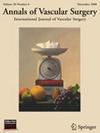Upper Extremity Arteriovenous Grafts are Less Likely to be Abandoned Compared to Autogenous Fistulas Despite a Higher Reintervention Rate
IF 1.6
4区 医学
Q3 PERIPHERAL VASCULAR DISEASE
引用次数: 0
Abstract
Background
Upper-extremity arteriovenous (AV) access often requires reintervention. However, the frequency of reinterventionsand subsequent access failure is not well-characterized. Our goal was to evaluate the frequency and type of reinterventions, risk-factors, and outcomes after AV access creation.
Methods
We performed a retrospective review of index upper extremity AV access creations (2017–2019) within the VQI Medicare-linked Vascular Implant Surveillance and Interventional Outcomes Network dataset for patients on hemodialysis (HD). Reinterventionswere defined as open or endovascular procedures on the access occurring at 1 day or more after access creation. Access abandonment was defined as any new access creation, peritoneal dialysis, kidney transplant, or death following index access creation. Univariable, multivariable, Kaplan-Meier, and Cox regression analyses were performed.
Results
There were 2,551 patients with an index AV graft (AVG) (19.5%) or AV fistula (AVF) (80.5%). Patients who underwent an AVG were more likely older, female sex, of non-White race, nonambulatory, not living at home, and to undergo the procedure as an inpatient (P < 0.05). Reintervention rates were 1.64/person-year for AVG and 1.17/person-year for AVF. On Kaplan-Meier analysis, freedom from new AV access creation at 3 years was 72% for AVG and 78% for AVF (P < 0.001). Freedom from tunneled dialysis catheter (TDC) placement at 3 years was 66% for AVG and 71% for AVF (P = 0.19). On multivariable analysis, undergoing placement of an AVG was independently associated with an increased risk of any reintervention compared to AVF (rate ratio (RR) 1.40 95% confidence interval (CI) 1.3–1.6; P = <0.001). TDC placement was increasingly associated with each subsequent reintervention but did not vary by access type. There was an elevated risk of access abandonment with subsequent reinterventions; however, long-term access abandonment was lower with an AVG compared to an AVF (RR 0.82 95% CI 0.7–0.96; P = 0.015).
Conclusion
Reinterventions to support HD access are common, and more than 60% of patients required at least one procedure within the first year of access placement. While patients with AVG require more reinterventions, they also have a lower rate of long-term access abandonment and similar rates of TDC placement compared to patients who receive an AVF.
与自体瘘管相比,上肢动静脉移植物放弃的可能性较小,尽管其再干预率较高。
目的:上肢动静脉(AV)通路经常需要再次干预。然而,重新干预的频率和随后的访问失败并没有很好地表征。我们的目的是评估再干预的频率和类型、风险因素和房室通路创建后的结果。方法:我们在VQI医疗保险相关血管植入物监测和介入结果网络数据集中对血液透析患者的上肢AV通道创建(2017-2019)进行了回顾性审查。重新干预被定义为在通路创建后1天或更长时间内进行的开放或血管内手术。准入放弃被定义为任何新的准入创建、腹膜透析、肾移植或在索引准入创建后死亡。进行单变量、多变量、Kaplan Meier和Cox回归分析。结果:2551例患者存在指数型房室移植(AVG)(19.5%)或房室瘘(AVF)(80.5%)。接受AVG的患者更可能是年龄较大、女性、非白种人、非流动、不住在家里,并且作为住院患者接受手术(结论:再次干预以支持血液透析通路是常见的,超过60%的患者在通道放置的第一年至少需要一次手术。虽然AVG患者需要更多的再干预,但与接受AVF的患者相比,他们的长期访问放弃率更低,TDC放置率相似。
本文章由计算机程序翻译,如有差异,请以英文原文为准。
求助全文
约1分钟内获得全文
求助全文
来源期刊
CiteScore
3.00
自引率
13.30%
发文量
603
审稿时长
50 days
期刊介绍:
Annals of Vascular Surgery, published eight times a year, invites original manuscripts reporting clinical and experimental work in vascular surgery for peer review. Articles may be submitted for the following sections of the journal:
Clinical Research (reports of clinical series, new drug or medical device trials)
Basic Science Research (new investigations, experimental work)
Case Reports (reports on a limited series of patients)
General Reviews (scholarly review of the existing literature on a relevant topic)
Developments in Endovascular and Endoscopic Surgery
Selected Techniques (technical maneuvers)
Historical Notes (interesting vignettes from the early days of vascular surgery)
Editorials/Correspondence

 求助内容:
求助内容: 应助结果提醒方式:
应助结果提醒方式:


